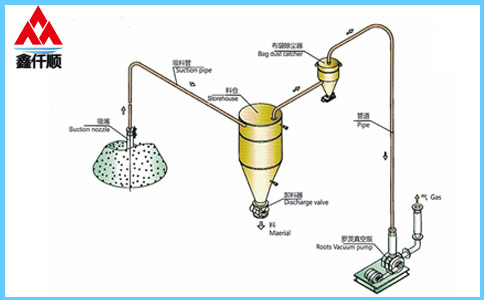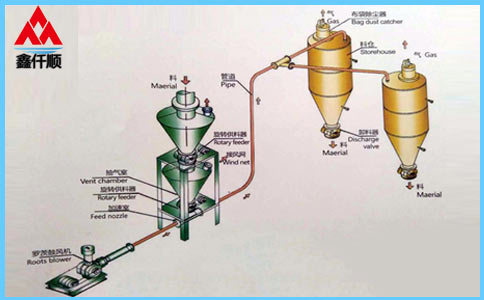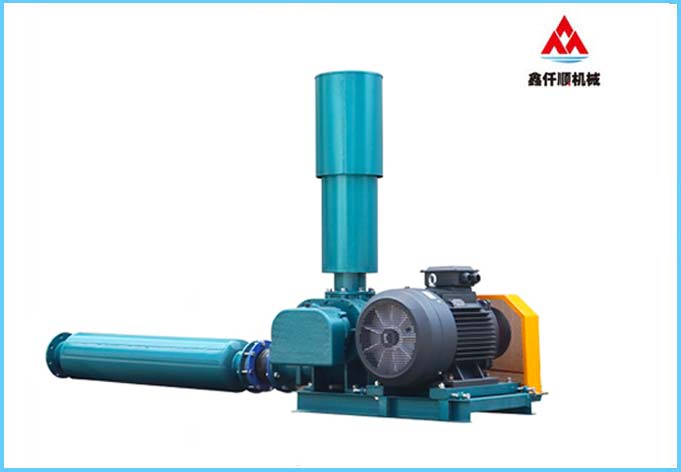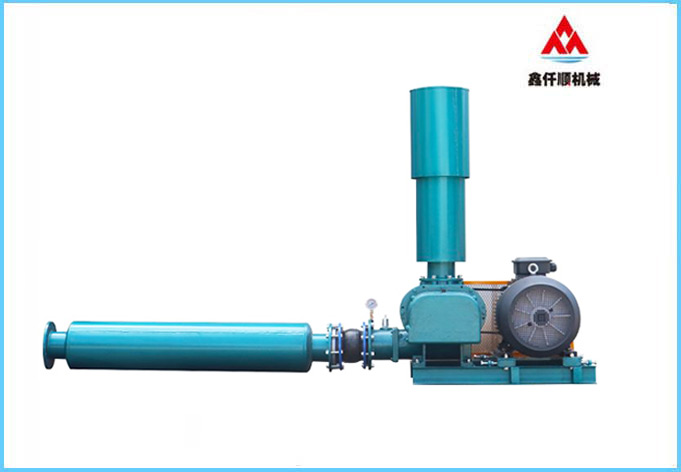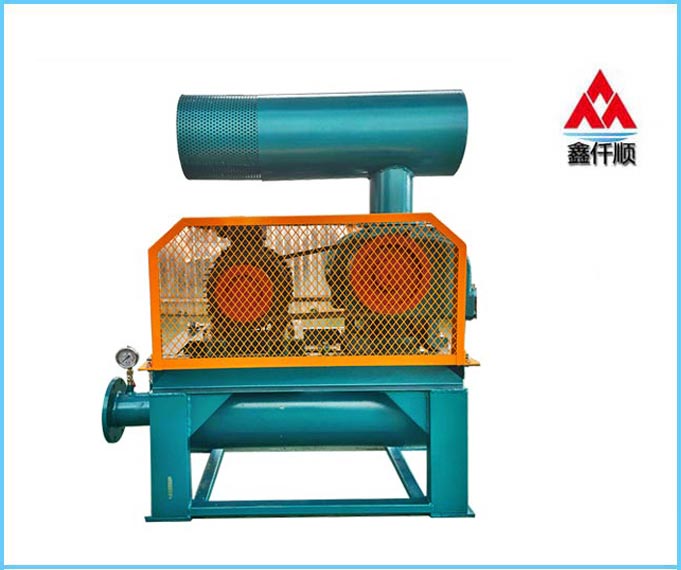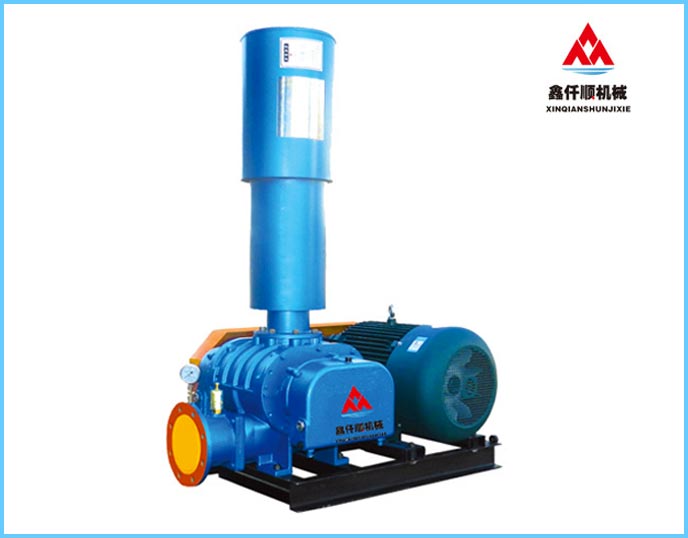Roots blower is a capacity rotary blower. Its characteristics are that when the pressure is adjusted within the allowable range, the flow change is very small, the pressure selection range is wide, and it has the characteristics of forced gas transmission. The medium does not contain oil during transportation. Simple structure, convenient maintenance, long service life and low vibration of the whole machine. What are the operating conditions of Roots blower? (1) The inlet gas temperature shall not exceed 35 ℃.
(2) The content of solid particles in the gas shall not exceed 1000m3, and the particle size shall not exceed the working side gap specified in Table 2.
(3) The coal tar index of gas shall meet the requirements of TJ28-78 City Gas Specification.
(4) The bearing temperature shall not exceed 85 ℃.
(5) The lubricating oil temperature shall not exceed 65 ℃.
(6) The pressure indicated by the air pressure gauge on the fan shall not exceed the pressure transformation range specified by the mark, otherwise, it is necessary to stop checking whether the system air inlet is blocked, whether the air inlet and exhaust gate valves are closed, and whether the static parts in the fan are rubbed, and take corresponding measures.
Working principle of Roots blower
There are two three blade rotors in the cavity, and suction ports and discharge ports are arranged on both sides of the cavity. Through the action of a pair of synchronous gears, the two rotors can rotate in the opposite direction, and rely on the mutual cogging action between the two rotors, so as to block the suction and discharge ports, and promote the gas in the cavity to achieve the purpose of blowing.
What preparations should be made before starting Roots blower?
(1) Check the installation quality of fasteners and locating pins.
(2) Check the installation quality of intake and exhaust pipes, gate valves, etc.
(3) Check whether the assembly clearance of the blower meets the requirements.
(4) Check that the coaxiality of fan and motor driving shaft shall not exceed 0.1mm, otherwise it will cause fan vibration, oil leakage and other phenomena, affecting the service life of fan.
(5) Check whether the periphery of the module base is well padded and whether the foundation screws are tightened.
(6) Before starting, the fan shall add lubricating oil into the main oil tank and auxiliary oil tank to 3mm/2mm of the oil pointer center. 68 # machine oil shall be used in summer, and 100 # machine oil shall be used in winter. The lubricating oil shall be replaced every three months.
(7) Because of the pressure in the main and auxiliary oil tanks, the upper and lower oil plugs of the main and auxiliary oil tanks should be tightened, otherwise oil leakage will occur.
(8) Apply water to the cooling section. The temperature of cooling water shall not exceed 25 ℃, and the cooling water volume shall be 10L/min.
(9) Open the gate valve at the air inlet and outlet of the blower to turn the rotor, and pay attention to whether there is abnormal noise at each part.
(10) Check the motor conversion, which must conform to the direction indicated by the conversion sign, or the fan cannot exhaust normally, which may cause fan blade impact. When the water is exposed to the water, it will flow into the fan in the opposite direction. When the air is transported, the transported goods will be sucked into the fan, causing an accident.
How to turn on Roots blower?
(1) First, check the fan environment and the good condition of the instrument electrical equipment (including normal three-phase power and continuous phase power).
(2) Check whether the lubricating oil of the fan is half of the liquid level mirror.
(3) Open the exhaust valve and outlet valve of the fan.
(4) Turn on the fan.
(5) After the fan operates normally, the vent valve slowly closes and the air pressure gauge of the fan rises to 0.04-0.05Mpa.
How to turn off Roots blower?
(1) When stopping aeration, open the vent valve slowly first.
(2) Close the outlet valve.
(3) Turn off the power.
Fan installation requirements
1. The foundation shall be firm and the surface shall be flat, 10-25 cm higher than the road surface.
2. Enough space shall be reserved around the fan to meet the needs of maintenance and disassembly.
3. The working environment temperature of the fan shall not exceed 400 ℃. If it exceeds 400 ℃, measures shall be taken to reduce the temperature, or the service life of the fan shall be shortened.
4. When the fan is equipped outdoors, please set up a rain shelter.
Pipeline requirements
1. The fan pipe shall be tightly connected without air leakage, and the support shall be set at the appropriate position.
2. The pipes shall be able to withstand the exhaust temperature and pressure. (Try to choose steel pipe)
3. Clean the inside of the pipeline. There is no foreign matter and sundries entering.
4. A one-way valve shall be installed on the pipeline to prevent the backflow high-pressure gas caused by fan reversal from entering the fan and damaging the fan. Note: The horizontal pipeline shall be installed with one-way valve.
5. In places where multiple fans run side by side, each pipe must be equipped with a gate valve (when one fan is under maintenance, it can reach the pipe).
6. Exhaust valve shall be set on the pipeline to prevent the fan from starting with load. After no-load startup, the fan shall gradually close the exhaust valve. When operating with load, the exhaust valve should also be opened first to ensure that the fan has no load, and then the fan should be closed.
Where does the oil in the main engine oil tank of Roots blower need to be added?
Fill it to half of the center line of the oil pointer.
How to carry out no-load operation and normal load operation of Roots blower?
(1) No load test run of blower.
1) The newly installed or overhauled fan shall pass no-load test run.
2) No load operation concept of Roots blower: put into operation when the gate valve at the inlet and outlet is open.
3) During test run, pay attention to whether the splash of lubricating oil is normal, and more or less adjust the oil quantity.
4) There is no abnormal smell or smoking, impact or friction sound, and the axial amplitude at the bearing position is not greater than 0.08mm.
5) 30 minutes of no-load operation. If the condition is normal, put into operation with load. If abnormal operation is found, it shall be checked immediately, and no-load operation is still required after troubleshooting.
(2) Normal load operation of blower
1) Adjust slowly as required, with load up to rated load. It cannot be adjusted to rated load at one time.
2) The rated load refers to the static pressure difference between the inlet and exhaust ports marked on the nameplate. When the exhaust pressure is normal, pay attention to the change of inlet pressure,
3) Due to the characteristics of Roots blower, the exhaust gas cannot be directly returned to the air inlet of blower for a long time, otherwise the equipment will be affected.
4) When the fan is in normal operation, it is prohibited to close the intake and exhaust gate valves and overload.
5) When the blower operates under rated conditions, the surface temperature of each rolling bearing generally does not exceed 85 ℃, the lubricating oil temperature in the oil tank does not exceed 65 ℃, and the axial vibration near the bearing does not exceed 0.08mm.
6) Always pay attention to the splash of lubricating oil and the position of oil volume.
(3) Parking
The blower should not be stopped suddenly before full load. It must be unloaded gradually before stopping to avoid damaging the machine. Users can discuss the emergency braking principle and clarify the rules.

